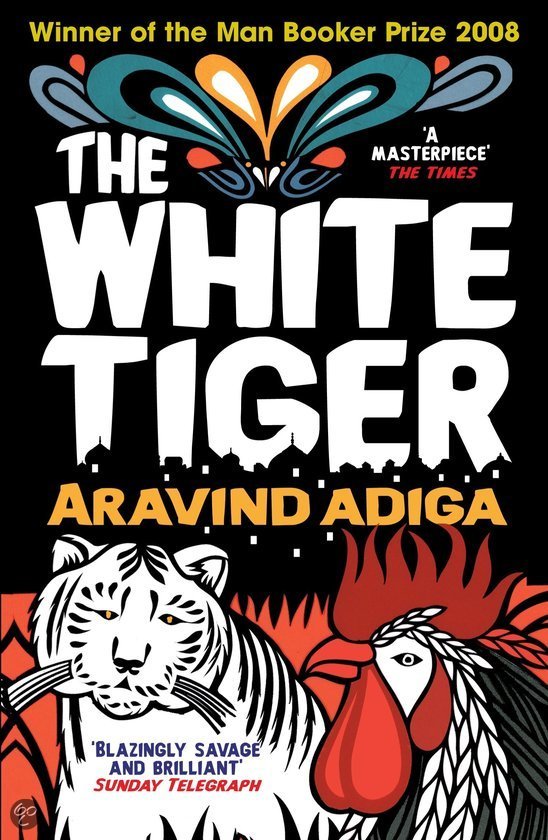Published November 6th, 2023
Review
by Viviana De Cecco
Author Aravind Adiga recently stated in an interview that his novel contains no autobiographical elements and that his characters are only figments of his imagination; yet, the story he narrates in The White Tiger (2008) seems rooted in his personal experience. The evocative and meticulous descriptions of the landscape, villages, and cities of Delhi and Bangalore were certainly inspired by the places where he spent his childhood and still lives today. Aravind was born in Mandras (now Chennai, in the state of Tamil Nadu, overlooking the Bay of Bengal) and proved to be one of the top students in his state from an early age. After attending St. Aloysius High School in 1990, he obtained his SSLC (Secondary School Leaving Certificate) with top marks. But English was not his only talent. When his parents moved to Australia, Aravind attended an agricultural school in Sydney and later enrolled at Columbia University and Magdalen College, Oxford, to study literature, eventually becoming a financial journalist for the Financial Times and an Asia correspondent for The Times. These jobs allowed Aravind to travel the world and return to India several times, eventually settling permanently in Mumbai to pursue freelance journalism.
His first-hand experiences give the reader a social, economic, and political overview of India that is very different from the tourist image we are used to. The White Tiger is a very distinctive book, steeped in black humor and cynicism. It is a story that deals with important issues, including the careerism, poverty, oppression, and corruption that dominate Indian society.
The book’s protagonist, Balram, writes first-person letters to the Chinese prime minister, who is scheduled to visit Bangalore. With biting sarcasm, he makes it clear early on that before he became an “entrepreneur,” he began his career as a driver for the wealthy Mr. Ashok. “Me and thousands of others like me in this country are half-baked because we were never allowed to complete our schooling,” he points out, describing how difficult life is in the small village where he was born, an unhealthy place where hunger, poverty, and death reign. “India is two countries in one: an India of light and an India of darkness.” On the one hand, the ocean brings light, while the Ganges is considered a river of death.
-fernando-morales:-the-globe-and-mail.jpg)
But the most interesting and disturbing aspect of the book is the caste system. The author compels us to understand what the true and deep meaning of this word is and what terrible suffering people who have the misfortune to be considered inferior beings have to endure.
We are used to seeing pictures in school textbooks of Mother Teresa of Calcutta caring for the untouchables, but the concept of caste that Aravind talks about is much more complex than a simple division of members of Indian society.
I should explain a thing or two about caste. Even Indians get confused about this word, especially educated Indians in the cities. They’ll make a mess of explaining it to you. But it’s really very simple. Let’s start with me. You see: Halwai, my name, means ‘sweet maker’. That’s my caste — my destiny.
So Balram delcares, as if caste were a prison from which there is no escape, a cage in which everyone must accept what life has given them without struggling to improve their condition.
Ironically, the protagonist claims that everything was fine in India before independence in 1947.
You see, this country, in its days of greatness, when it was the richest nation on earth, was like a zoo. A clean, well-kept, orderly zoo,” but when the British left, “the cages had been let open and jungle low replaced zoo low. […] In the old days there were one thousand castes and destinies in India. These days, there are just two castes: Men with Big Bellies, and Men with Small Bellies. And only two destinies: eat — or get eaten up.
This means that the law of the fittest and those who use violence to enrich themselves at the expense of the weakest rule. His father, though from the Halwai caste, does not work as a sweets maker but as a rickshaw puller because, according to the son,
when he inherited the shop, a member of some other caste must have stolen it from him with the help of the police: My father had not had the belly to fight back.
In fact, the police is a corrupt body that serves the interests of politicians or the wealthiest, such as the landlords who rule over rural villages where the poor suffer their abuse in silence.
In Balram’s village, the landowners have been given animal nicknames such as “The Buffalo,” “The Stork,” “The Wild Boar,” and “The Raven,” to emphasize the cruelty and aggressiveness of these conscienceless men.
In contrast, Vijay, the son of a swineherd, who has risen from the lowest of the low to become the village bus driver, embodies the model of a successful man in the eyes of the younger men. As we read on, we discover that government employees earn so little that even teachers are forced to steal, while miners are more respected because they tell interesting stories, drive nice cars, and have above-average salaries. In the cities, the situation changes little. The rich live in residential areas, find it normal to beat up their servants, go to parties to get drunk, while their drivers wait for them for hours in the mosquitoes and sweltering heat. On the streets of Delhi, you can even see drivers of small rickshaws carrying heavy furniture to be delivered directly to the homes of the rich.
The poor live on the streets amidst hunger and filth, dying of malaria or tuberculosis in hospitals where doctors often do not even show up.

The Indians are trapped in what Balram calls “the Rooster Coop,” an image he uses to describe his people as a collection of honest individuals who lack the courage to rebel. That is why those who try to escape their condition are called “the White Tiger,” the most intelligent animal in the jungle. When Balram was a child, it was a school inspector visiting his village who gave him this nickname and encouraged him to use his brilliant mind to change his future.
I was particularly struck by the statement that millions of people agree to submit to the power of a few. Why doesn’t anyone rebel? How have a few smart men subjugated other smart men? In response to these rather common questions, Aravind writes in the last chapters of the book that Indians are not interested in fighting for freedom, but are waiting for foreigners, like Chinese or Americans, to do it for them.
It’s because 99.9 percent of us are caught in the Rooster Coop just like those poor guys in the poultry market. Here in India we have no dictatorship. No secret police. That’s because we have the coop. [...] But leave a million dollars in front of a servant and he won’t touch a penny. [...] He’s no Gandhi, he’s human, he’s you and me. But he’s in the Rooster Coop. [...] The trustworthiness of servants is the basis of the entire Indian economy.
Faced with this terrible reality, I myself felt a sense of anger and despair at this docile resignation. But Balram explains that Indians do not avoid conflict because they are stupid or cowardly, but for a more important reason.
Only a man who is prepared to see his family destroyed — hunted, beaten, and burned alive by the masters — can break out of the fold. It would take a freak, a pervert of nature. In fact, it would take a White Tiger. You are listening to the story of a social entrepreneur, sir.
But what puzzled me even more was the fact that even servants “need to abuse other servants. It’s been bred into us, the way Alsatian dogs are bred to attack strangers. We attack anyone who’s familiar. [...] Servants, incidentally, are obsessed with being called ‘sir’ by other servants.” I found both this total lack of solidarity between people who share the same condition of poverty and abuse, and the careerism that dominates almost everyone, from servant to master, disturbing and annoying. With the story of Balram and the tragic events that unfold in the novel during his social rise, Aravind has succeeded in perfectly describing how the thirst for money is a scourge of both Indian and especially American and Chinese, societies.
Delhi is a city where young people sleep during the day and work at night, where prostitution and illegal businesses are rampant, where the source of income for the wealthiest comes from outsourcing, a business that Balram describes as “doing things in India for Americans over the phone. Everything flowed from it — real estate, wealth, power, sex. So I would have to join this outsourcing thing, one way or the other.” The character of the protagonist embodies the model of the unscrupulous and unethical entrepreneur who is willing to go so far as to kill in order to make money.
Although it is a raw and shocking book, I think the Booker Prize it won in 2008 is more than deserved. This reading taught me that none of us can judge from the outside without knowing the true face of India, a country full of contradictions that sometimes reflect a humanity not so different from that of the West.
Nationality: Italian
First Language(s): Italian
Second Language(s):
English,
French,
Spanish
Supported by:

